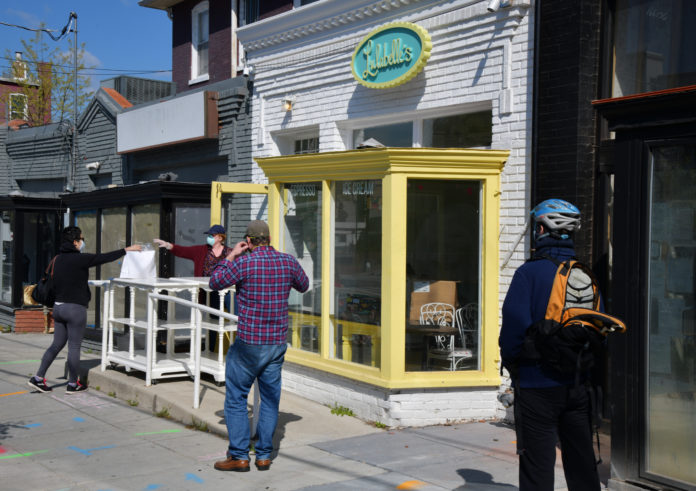
Julie Wineinger knows the ins and outs of managing bulk ice cream orders.
Now in the age of the coronavirus pandemic, she’s calculating: How many potatoes equal a pound?
Wineinger closed Lulabelle’s Sweet Shop last month when D.C.’s city government imposed sharp restrictions on dine-in food service. She worried that her small store would get too cramped with customers perusing for their favorite pints. And she wanted her staff members to be able to file for unemployment benefits before the system got inundated.
To sell ice cream that was already in stock, Wineinger offered contactless curbside pickup. Then she noticed posts online from people scouring for milk, flour, eggs and other staples increasingly hard to find.
“All of the suppliers I’ve reached out to have been super willing to do whatever they can,” Wineinger said. “They don’t have any business and they’re all trying to stay afloat. It’s just about trying to get people what they need.”
The coronavirus shutdown dealt a piercing blow to the restaurant industry, which has shed 3 million jobs and suffered a decline of $25 billion in sales, according to the National Restaurant Association. But as restaurants scramble to serve takeout and hold onto as many employees as possible, they’re embracing – and scratching their heads at – a new enterprise: groceries.
That also means the country’s food industry is quickly recalibrating to get people the goods they need, blurring the networks and supply chains that have stocked supermarkets and restaurant kitchens for decades.
This week, Panera Bread – where sales are down as much as 50 percent – started selling fruits, vegetables, breads and dairy products at more than 1,800 locations. More than 30 Denny’s locations in California and Oregon are selling numerous items. Customers at over 100 Subway branches in Southern California can add sliced pastrami and dill pickles to their lists.
At Lulabelle’s, Wineinger has added produce and fresh bread to her menu. Orders are available for pickup during a three-hour window on Saturdays.
“I’m not a grocer, I didn’t have grocery store contacts,” Wineinger said. “I’m just trying to figure this all out as I go.”
For scores of restaurateurs, “figuring it out” involves a substantial rejiggering of the country’s food supply systems. Measured by volume, about 25 percent of the country’s food typically goes to restaurants and food service, with the remaining three-quarters going to retail and grocery stores, said David Henkes of the food-service consulting firm Technomic. (It’s closer to a 50-50 split if you measure dollars spent by customers.)
There are other shakeups at play, too. Henkes pointed to the spike in unemployment that could pull restaurant workers into jobs with delivery services, warehouses or e-commerce giants.
“The grocery supply chain is being pushed and stretched in ways it hadn’t been before,” Henkes said. “We’re going to see some kind of fundamental realignment of how food distribution works.
Still, Henkes said the revamp may not work in the long-term. A restaurant’s value add – and chance to make a profit – doesn’t come from selling sliced bread and avocados, but from plated avocado toast.
“It would be very hard, with the way restaurants are structured right now, to really be successful in converting to a bodega, a pantry or a grocery store,” Henkes said. “It’s just not how they’re built.”
But that hasn’t stopped restaurants from mobilizing to fill an urgent need. Roboghene Reed is a Denny’s district manager in San Bernardino, Riverside and San Diego counties. Reed is in her 30s and said she doesn’t worry too much about getting herself to a grocery store. Instead, she’s concerned about the elderly and immune-suppressed, or people trying to protect their loved ones.
“We’ve had one customer whose mother is battling cancer, and they don’t want to expose her,” she said. “So they can just drive up and we put the box in the trunk.”
At The Alibi, a British American pub on Capitol Hill, sales relied on surrounding businesses and tourism, said Rachel Traverso, one of the owners. Once the pandemic hit, Traverso and her colleagues mapped out prepared meals customers could take home, produce from farms in Maryland and North Carolina, sliced deli meat and bread from a local bakery. Orders of $25 or more come with a free roll of toilet paper. For the four-legged among us, The Alibi will soon be selling dog food.
Gordon Banks had to laid off 100 people who worked at his restaurants in mid-March. He has rehired about 25 employees, in part through grocery sales at three of his District locations: Bar Charley, El Chucho and Little Coco’s.
Banks is pairing takeout cartons of Bolognese and al pastor tacos with strawberries, romaine lettuce, dish soap and laundry detergent. Banks said he’s sold 300 rolls of toilet paper; one recent order requested 18 rolls, plus 12 containers of hand sanitizer. Also on the offering: handmade face masks and Easter dinner.
Banks is hoping to rehire as many as 10 new employees, using his restaurant’s roofs or back patios to keep staffers six feet apart.
“The number one goal right now is to get as many people back to work without losing money,” Banks said. “I’m trying to charge grocery store pricing. I search every item on Pea Pod and I’m like, ‘Can I make a buck? Literally a buck.’ ”
(c) 2020, The Washington Post · Rachel Siegel
{Matzav.com}











